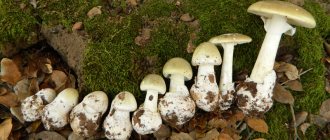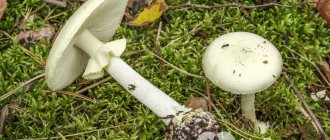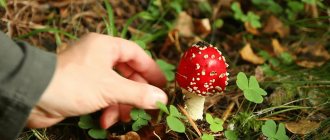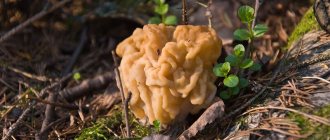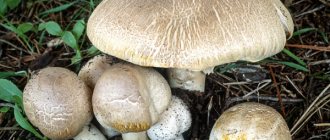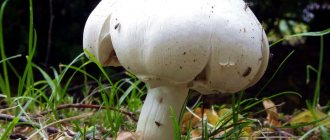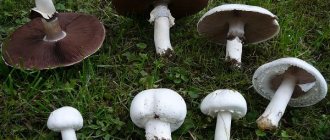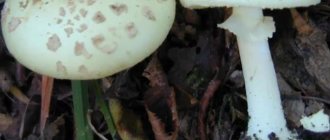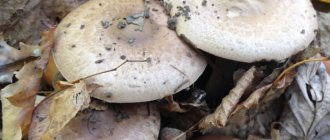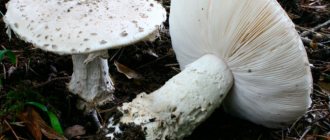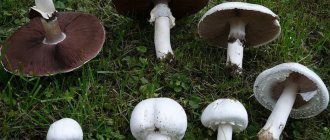Every edible mushroom has poisonous counterparts. Many of them are easy to calculate, but there are such types that only a careful comparison helps to figure out which forest gift can be put in the basket. For example, toadstool and champignon are so similar in appearance to each other that even an experienced mushroom picker is not always able to distinguish them. Therefore, knowledge of the differences can prevent poisoning and more dangerous consequences.
What does champignon look like?
Differences
And yet, if you look closely, champignons and toadstool have a number of differences.
The first is the unusual structure of the leg. The toadstool has a noticeable thickening at the soil level, and also has a skirt that protects the mushroom. Champignons also have it, but during development it smoothes out or disappears altogether. The edible mushroom does not have a thickening, and the ring located above is very thin and invisible. The plates under the cap of the pale toadstool are not as white as those of the edible mushroom. As they develop, the plates become pink, less often brown. An adult specimen may have a grayish or even greenish tint
You should also pay attention to the thickness of the stalk. A good mushroom has a thick, dense structure, a toadstool is thinner, and also breaks with one touch
The color of the cap is also different. In an edible fruit, it may darken as a result of exposure to the environment, but never turns green or gray. Artificially grown pecheritsa do not smell at all (this also applies to pale toadstool), but forest fruits have a subtle aroma of forest or almond. This allows you to distinguish them from each other.
Even insects and animals do not eat poisonous varieties, so worms are not found in them, which is typical for wild pechets.
Camera glitches on xiaomi redmi 6a - Restoring work
Published: 06/08/2019 The camera on xiaomi redmi 6a is glitchy and slows down a lot at dusk. I tried changing modes in the settings, it didn't help. Help solve the problem. The main camera on Xiaomi does not turn on. It shows a black screen, but the selfie camera is working, what should I do? When you launch the camera on Xiaomi Redmi 6a, the message “camera not found” pops up. Recently it fell on a stone with its back side, how can I repair my smartphone? When shooting with my Xaomi, the image slows down greatly, making it impossible to shoot. help restore. Contents1 Camera glitches on xiaomi redmi 6a.2 Correct configuration of the device3 Hardware solutions Camera glitches on xiaomi redmi 6a. While using your Xiaomi Redmi 6a phone, you may notice that the camera is glitchy. This manifests itself in the inability to focus the image normally, the absence...
Names and descriptions of dangerous twin mushrooms
Champignon has doubles that pose a great danger to human life, since they pose a mortal threat:
- death cap;
- light fly agaric (white, smelly).
Since dangerous look-alikes have a similar light color, and are also found in coniferous and mixed forests in the summer and autumn months, mushroom pickers may confuse them with coppice champignon. Young individuals of both species have the same appearance: caps, plates, rings and scales on the stem. As they grow older, the plates of a real champignon change color, but those of a toadstool remain the same.
Unlike champignon, if you press on a poisonous mushroom, it will not turn yellow. In addition, toadstools have root sacs (volvas) into which the legs are inserted. Pale toadstool is dangerous because it does not have an unpleasant, repulsive odor, like fly agaric. To obtain fatal poisoning, it is enough to consume 1 gram of toxic raw materials per 1 kg of weight.
Signs of poisoning by poisonous doubles begin to appear some time after their consumption, so it may be too late to provide any life-saving action
In view of this, before harvesting forest products, it is important to carefully study the distinctive features of real champignon and false champignon.
Virulence
The pallid grebe prefers a lot of moisture. It is practically not found in places with arid climates. During the rainy season, the growth of toadstools accelerates. You can meet mushrooms either individually or in a group. In areas with high humidity, the number of these dangerous fungi increases significantly.
It is important to know that even if one toadstool ends up in a basket of edible mushrooms, almost all the mushrooms will be poisoned by the toadstool's poison. Even if you identify one type of toadstool, you will have to say goodbye to the entire harvest. It is important to protect yourself and others from the extremely dangerous consequences of eating poisoned mushrooms.
Not only the fruiting body of the toadstool is endowed with a large number of toxins. The spores and mycelium of this fungus are also extremely dangerous. If the toadstool grows near berries or other forest products, then it is better to avoid this area. Even a minimal amount of poison can cause serious poisoning.
Note!
Despite the fact that the toadstool and champignon are extremely similar to each other, it is quite easy to distinguish them. If, when picking mushrooms, doubts arise about any tasty gift from the forest, then it is best not to take a suspicious specimen, thus protecting yourself and your loved ones in advance.
There is even a folk method for determining whether a collected mushroom is poisonous. To do this, place a small onion in a saucepan with the gifts of the forest that have aroused suspicion. Fill with water and leave until boiling. If the bulb has acquired a bluish tint, then the suspicions were not in vain and there was a poisonous one in this bunch of mushrooms. However, you should always remember that this method of determining the edibility of champignons will not be valid every time. Even after such a check, it is possible to confuse a poisonous mushroom.
Do not forget about another important feature of the pale grebe. She can throw her spores around
Therefore, in order to protect yourself, it is best to refuse to collect mushrooms near poisonous ones in advance.
Places of distribution
The dangerous similarity between the toadstool and the edible champignon is also due to the fact that both mushrooms grow in the same habitat. However, there are still small differences. These include:
- The pale grebe prefers to grow in deciduous forests, choosing places near trees and shrubs. Most often it can be found under beech, hazel and oak. It is also found in mixed forests. The fruiting period lasts from late August to late November;
- Champignon chooses moist soil rich in humus and fertilizer. Various varieties can grow both in forest areas and in steppes and deserts. They are often found on meadow humus, the bark of dead trees, anthills and tall bushes. Fruiting lasts from late May to late November.
It is recommended to collect mature and young mushrooms, since in this form it is much easier to distinguish them from each other.
Field champignon
The benefits and harms of champignons
Since spherical mushrooms are rich in folic acid, which is essential in the production of red blood cells, metabolism, and the functioning of the cardiovascular, nervous and digestive systems, they have a positive effect on the human body. In addition, acid plays an important role in a woman’s reproductive system, participating in the formation of the placenta and the healthy development of the fetus. The presence of amino acids, vitamins and minerals in the forest product also benefits pregnant women.
Mushrooms have low calorie content, high energy value, and contain a large amount of proteins and antioxidants, which makes them dietary and accessible to patients with diabetes.
For example, champignons contain more B vitamins than fresh vegetables. Thanks to the large amount of plant fiber and beneficial properties, dishes made from this product not only quickly satisfy hunger, but also help improve metabolism. That is why nutritionists recommend eating champignons for those who want to lose extra pounds, as well as for strengthening muscle mass in the gym. In addition, the dietary product improves memory and concentration.
To prepare traditional Russian food from champignons, you should use sunflower oil, which is used for frying and seasoning all tubular mushrooms. Processing champignons includes both cooking and preparation for consumption.
When collecting champignons, it is important not to confuse them with their poisonous counterparts, which will be harmful to health. It is not recommended to collect mushrooms in unsafe areas (near industrial enterprises, highways, landfills), since the fruiting bodies absorb harmful substances from the surrounding atmosphere
A canned product made from raw materials that was stored incorrectly or in violation of the preparation technology can cause harm to health. It is advisable for pregnant women not to eat salted, pickled and dried mushrooms. If you have allergies or problems with the digestive system, you should also avoid the herbal product.
How to identify poison during cooking
The composition of toxins is not the same in different types of mushrooms, as is their effect on the body, so there is no universal way to identify poisonous varieties during cooking.
During the first cooking, place a peeled onion or several cloves of garlic into the pan. If there is tyrosine in the water, the vegetables will turn brown.
Under the influence of the poisonous enzyme pepsin, milk curdles. Therefore, to test, mushrooms are placed in the liquid. However, some edible species contain a certain amount of pepsin, so the method cannot be considered reliable.
When cooking mushrooms, do you determine the poison content in it?
Always Now I will
Description of mushrooms
Edible champignon is distinguished by the following external characteristics:
- the total size of the cap and stem can vary from 3 to 20 centimeters;
- The shape of the cap is predominantly semicircular and convex. The texture of the pulp is dense;
- the skin covering the cap is easily damaged;
- color can vary from pure white to brownish tint;
- the plates under the cap may darken as the mushroom ages;
- there may be two rings on the leg. The texture of the leg is soft and fibrous;
There are also three varieties of conditionally edible and toxic champignons. These include:
Red champignon
The cap of this champignon can reach 15 centimeters in diameter. Young mushrooms with a rounded cap, which later becomes bell-shaped. They are distinguished by the presence of pinkish plates, which acquire a brown color as the mushroom ages. It can also be distinguished by the presence of a chrome-yellow zone in the base area when viewed longitudinally. The flesh of the russet champignon turns yellow when broken. The smell of the mushroom is extremely unpleasant and repulsive. Poisoning is not fatal, but has serious consequences.
Variegated champignon
The cap of this representative is rounded, which straightens as the mushroom ages. On the surface of the cap there are grayish or brownish scales. A large cluster of scales is located in the center. The plates can change color from white-pink to brown. The leg has a yellowish color, which darkens with age. You can distinguish them by their unpleasant smell. In many sources, variegated champignon is considered a poisonous mushroom, so it should not be consumed.
Flat-headed champignon
This representative has an ovoid cap that straightens as the mushroom ages. There is a small tubercle in the center. The cap itself is covered with a large number of gray scales. The plates of young mushrooms are pink, but darken as the mushroom grows. The pulp on the break becomes yellow or brown in color. The smell is chemical and repulsive. Eating this mushroom causes intestinal upset.
Consumption of all these varieties of champignons can provoke attacks of poisoning. Eating them is not recommended. However, the real enemies are the pale toadstool and the stinking fly agaric, poisoning from which can have fatal consequences.
Pale toadstool differs from champignon in a number of ways, namely:
- the shape of the fruiting body of young mushrooms looks like an egg covered with a thin film;
- The diameter of the flat cap of an adult representative reaches 15 centimeters. There is a characteristic tubercle in the center;
- The leg has a cylindrical shape and thickens towards the base;
- The plates under the cap are white and are located free.
The taste of young pale toadstool has a sweetish aftertaste, while old mushrooms become cloying. Most of these mushrooms are odorless. The flesh is cream or white.
Poisoning
The danger of toadstool lies in the chemical composition of this mushroom. It contains a whole group of poisons, the use of which has an extremely detrimental effect on the condition of the human liver, causing gradual tissue necrosis. Most often, consumption of toadstool ends in death. The danger of the toxins contained in this mushroom is that the first symptoms do not appear immediately, and irreversible consequences in the body begin after taking this insidious mushroom
It is also important that toadstool cannot be distinguished by taste. It does not have any poisonous taste
Symptoms of eating toadstool appear after at least 12 hours. The first signs of damage include: severe headache, constant vomiting, unquenchable thirst, muscle pain, bloody diarrhea, and vision problems. In some cases, signs of poisoning may appear, such as a weak pulse, yellowness of the skin, and low blood pressure. Children may experience seizures. If you do not consult a doctor, then on the 3rd or 4th day some of the signs of poisoning may go away. However, this does not mean that the healing process is underway, since the poison continuously and mercilessly destroys healthy cells of the body. Death occurs 7-10 days after poisoning. The sooner you turn to professional help from doctors, the greater your chances of survival. When the first symptoms of poisoning appear, you must urgently call an ambulance.
It is important that during poisoning with toadstool, you should not use any alcoholic drinks for the purpose of disinfection and removal of toxins. Poisons spread throughout the body much faster when in contact with alcohol.
This way you can greatly speed up the poisoning process. The best thing that can be done for the patient is to call a doctor in time.
Why Meizu M5c does not see the computer
If a person connects a smartphone to a PC via a USB cable, but the computer does not react at all, it means that the user is faced with one of the following problems:
- cable fault;
- failure of the USB socket on one of the devices;
- Incorrect drivers for the smartphone are installed on the computer, or there are none at all;
- When connecting, the “Charging only” option is selected;
- failure of the operating system of one of the devices.
Thus, all identified problems can be divided into physical and software. To determine the exact reason that the Meizu M5c phone does not see the PC, you need to check the hardware and settings of both devices.
Champignon
Generally recognized by lovers of the “quiest hunt,” the king of mushrooms, the champignon, has amazing taste when the rules of its preparation are followed. Such a trophy becomes desirable in any basket, and this variety can be distinguished from other “hat” neighbors by its characteristic external features.
A small champignon, recently grown from the ground, has a spherical cap, but over time and growth it becomes more and more flat. The diameter of the cap can reach up to 10 cm. Depending on what particular subspecies of champignons you come across, the cap can have different colors: from white to brown and brown. As for its surface, it does not always have a smooth structure: sometimes, by running your finger over it, you can feel small hard scales.
Common edible champignons, also called pecheritsa, grow in Europe, as well as in many Asian countries where a temperate continental climate prevails. This mushroom can often be found even in park areas, vegetable gardens and orchards near the city. True, in the first case it is better to refrain from eating it. It is best to collect champignons in fields and forests away from city limits and large production enterprises. You can find champignons from July until the first frost, and if you are lucky enough to find a “lucky clearing” with them, then you can visit it for a new “harvest” approximately every two weeks.
Cautions
When collecting, you can easily make a mistake, and the basket will end up with something other than a champignon, but a toadstool that looks very similar to it in appearance. The surest way to protect yourself is not to pick mushrooms that you have even the slightest doubt about.
You can understand how safe the harvest harvested in the forest is using one folk method. It is boiled in separate containers, after throwing the onion into the water. If poisonous representatives are found in some pan, the onion will turn blue, whereas in a pot with normal ones it will not change color. This method is not always valid.
It is very important to remember that the toadstool is dangerous not only if it is eaten, it also scatters toxic spores around itself. Therefore, if you have already found one such poisonous mushroom, then you should not collect any forest gifts near it - the risk of poisoning is too great.
Many of us adore mushrooms, especially wild mushrooms. Of course, wild mushrooms are much more flavorful and varied than store-bought ones. But when collecting or purchasing such mushrooms, the possibility of getting poisonous ones, which are almost no different from edible ones, cannot be ruled out. The most dangerous representative of the poisonous kingdom is the toadstool.
What is the difference between toadstool and champignon?
Despite the fact that it can be difficult to distinguish a deadly poisonous mushroom from an edible one, there is still a difference, and it is quite big. It is enough to carefully study the comparison of the pale toadstool and champignons in order to accurately determine the variety of the find.
By appearance
There are several signs by which champignon and the deadly poisonous white fly agaric can be distinguished externally:
- Despite the same structure and size of the leg, in the pale grebe it is usually thinner and not as fleshy.
- The thickening in the lower part of the leg of the pale grebe is a volva - a kind of sac from which the poisonous white fly agaric is born. An edible mushroom does not have such a sac; the stem simply thickens at the surface of the ground.
- The color of the upper and lower parts of the cap of the toxic white fly agaric is the same - white, slightly yellowish or greenish. But the edible mushroom has slightly pinkish flesh under the cap.
An adult champignon has a small dent in the center of its cap. In the grebe, on the contrary, there is a tubercle in this place, although it may be smoothed and poorly visible, making it impossible to clearly distinguish the difference.
Attention! As a rule, the poisonous pale toadstool looks much more attractive than the edible champignon. This is due to the fact that the poisonous mushroom is rarely touched by insects and worms, it retains a fresh and beautiful appearance
By smell
If you smell the pale toadstool, you will not be able to sense any specific aroma; it smells of practically nothing. And the edible pulp emits a noticeable and rich mushroom smell with a slight almond tint, which makes it possible to correctly distinguish a safe fruiting body.
When cutting
If you cut the cap of an edible champignon, it will quickly darken, but the toadstool will remain white when cut. The stem of the edible fruiting body is uniform at the break, but the poisonous white fly agaric has a peculiar rod inside the stem - a section of pulp that is very different in structure.
Fruiting bodies can also be distinguished by the degree of elasticity of the pulp. In edible mushrooms it is dense and elastic, but in the poisonous white fly agaric it crumbles greatly.
When cooking
If the species identity of the mushroom is in doubt after it was brought from the forest, you can distinguish the pale grebe in the following way. The suspicious fruit body is placed in water along with a small onion, placed on the stove and wait until the water boils.
If the onion in the pan turns slightly blue, then there is no doubt that there is a toadstool in the boiling water. When boiling the edible pulp, the onion will not change its color.
Advice! It is better to distinguish champignon from the poisonous white fly agaric while still in the forest; checking during boiling is only suitable as a last resort.
Differences
Despite the very precise similarity of these two species, it is enough to know a couple of signs by which they can be easily distinguished from each other. These include:
- Difference in size at the base. The pallid grebe is distinguished by its thinner diameter at the base and dry texture;
- Hat shade. The color of the cap of the pale grebe may have a greenish tint or no shade at all. The champignon is easily distinguished by its pinkish color;
- The pulp of the poisonous toadstool has virtually no odor. Champignons have a rich mushroom aroma reminiscent of almonds;
- Pallid grebes do not have parasitic insects. Their fruiting bodies are almost always in perfect condition, which cannot be said about champignons;
- The diameter of the thickening of the toadstool is larger than that of the champignon. This is due to the fact that the pale grebe has a volva at the base. The volva is ovoid in shape, while the champignon is simply slightly thickened;
- The easiest way to identify an edible mushroom is to cut off some of the flesh. In the pale toadstool, the color will remain snow-white, but in the edible mushrooms, the flesh will begin to darken.
Since ancient times, a method was created by which mushroom pickers distinguished edible and poisonous mushrooms. To do this, all suspicious mushrooms were boiled with a large white onion. If the onion turns blue during cooking, the mushrooms are considered inedible. However, you should not rely only on this method, since it does not guarantee 100% safety of the selected mushroom.
Death cap
Technology for growing champignons in the garden
Those who want to grow mushrooms in an open area need to know some nuances, since champignons are quite whimsical. They do not like bright light, so any shaded area is a suitable place to build beds. To protect the soil from drying out, you should make a canopy.
The first step is to prepare the compost. To do this, lay layers of straw, manure and litter. Water every day, avoiding drying out. After 3 weeks the compost will be ready.
It is necessary to sow mycelium (a kind of mushroom seeds that can be purchased in the store) onto the loosened soil, cover with a 5-centimeter layer of compost and water. Fruiting occurs after 2.5 months.
For those who plan to grow mushrooms all year round, it is important to know that champignons do not need lighting, so for the winter they can be moved to any damp and warm room with an air temperature of at least +15 degrees
Rows grow in any summer
I started collecting another row already in Kostroma. Small in size (30-50 mm), it appears for a very short period, 7-12 days, on open coniferous litter under the canopy of old spruce trees. The hat of this row is a beautiful beige color (more like the color of fallen pine needles), looks a little velvety, but is actually smooth. The plates and stem are yellowish. The mushroom is quickly attacked by a worm, but in damp weather it remains clean for a long time. I tried to fry it, it’s a good mushroom. But more often I send them to salting. In general, all rows of mushrooms mixed with other pickling mushrooms fully correspond to the title of pickles. And most importantly, rows always happen. Even in the driest summer.
Part 1, Part 2, Part 3
Symptoms of poisoning, first aid
Despite all the signs that allow you to distinguish an edible find from a white fly agaric, even experienced mushroom pickers are not immune to mistakes. Therefore, it is necessary to know the symptoms of poisoning:
- The first signs of poisoning appear 8-30 hours after consumption. At first, no alarming symptoms are noticeable; the poison is still spreading throughout the body.
- Then an acute gastroenterological reaction occurs - vomiting and diarrhea, severe abdominal pain begin, and this condition continues for up to 2 days.
- After this, the person feels better for some time - symptoms may disappear for 2-3 days, but the poison still remains in the body.
- After a few days, the symptoms return, but at the same time they are accompanied by sharp pain in the right side, jaundice, blood pressure drops, and the patient experiences liver and kidney failure.
In the absence of medical care, death occurs 10-12 days after poisoning. However, if you consult a doctor in a timely manner, a person can be saved. At the first signs of poisoning, you must call an ambulance. While doctors are traveling to the patient, you need to give the person to drink about 2 liters of water, and then induce vomiting so that most of the poison leaves the body.
Important! In case of mushroom poisoning, it is absolutely impossible to stop vomiting and diarrhea with pharmaceuticals - this will worsen the situation, since toxins will remain in the body. https://www.youtube.com/embed/-QTWY5u8R_8
Comments (8)
- barkovsky18.02.2018 at 12:55
Which website should I use to link the card? Reply ↓
You need to link the card in the application itself. We have an article with detailed instructions. Reply ↓
It’s all so complicated, how you have to play magic with a tambourine, I went to Meiza for six months and bought an iPhone and forgot about it. Reply ↓
Some people, on the contrary, like more complex devices so that they can optimize it for themselves) Reply ↓
On the fifth fly pro 5, it’s all there even without a tambourine. Add pay to admins and link the card in the Sberbank application. Reply ↓
and in more detail and preferably step by step? Please Reply ↓
how to add pay to admins? Reply ↓
Why the hell does he need this nfc. I'm not an idiot to keep money on such a card Reply ↓
Differences and Similarities
Mushroom doubles are a normal phenomenon; almost every species has them, but some are easy to identify, while many require some tinkering.
You can understand how champignons differ from their poisonous twins, toadstools, by examining each species in detail. All differences must be remembered in order to avoid troubles and possible poisoning of the body.
Similarities:
- Both types of mushrooms are similar in size. The average size of the cap is about fifteen centimeters, and the stem varies from seven to sixteen centimeters.
- There are characteristic rings on the trunk of each type of mushroom. In poisonous individuals, such a ring fades over time, but in edible ones it remains full and covers the lower part of the cap almost entirely.
Differences:
- The first sign by which mushrooms can be distinguished is the base. The trunk of the toadstool is thin and “thin,” while that of the champignon is fleshy and thick.
- For comparison, you can take the caps of two mushrooms - both sides of the toadstool will be the same white color, and the bottom of the champignon cap will be pinkish. In rare cases, the cap of the toadstool may turn green.
- The toadstool leg is thin, and its flesh is dense and hard.
- A characteristic difference between the two types of mushrooms is the smell. Toadstool has absolutely no odor, and champignon has a peculiar mushroom aroma that is difficult not to notice even when cut.
- It is impossible to find parasites on inedible mushrooms - insects spoil only edible mushrooms.
The danger of the toadstool
Any poisonous mushrooms are unsuitable for consumption due to their chemical composition - they cause intoxication of the body, accompanied by unpleasant symptoms and posing a danger to human health and life.
Double mushrooms often grow next to edible representatives of their world, so it is necessary to know not only the differences, but also the likely consequences of collecting harmful mushrooms in order to take a responsible approach to the selection process.
If the amount of the substance is small, there is still a chance to relieve the symptoms of poisoning and rinse the stomach, but it is better to avoid such experiments and determine in advance whether the mushroom is poisonous.
Effect of poison
Pale toadstool is a rather insidious mushroom. The problem is not only that it is difficult to immediately recognize poisoning.
Intoxication occurs in several stages, which can confuse the patient and doctors:
- A few hours after poisoning, abdominal pain, nausea and vomiting begin.
- This is followed by a false recovery - the patient feels better, but this does not mean that the effect of the poison has stopped.
- After the waiting period, acute pain in the stomach, a noticeable change in skin color, and loss of consciousness occur.
- Death occurs within ten days after eating a poisonous mushroom.
Not only the main parts of the fungus are poisonous, but also the spores. To poison the body, it is enough to consume thirty grams of mushrooms.
